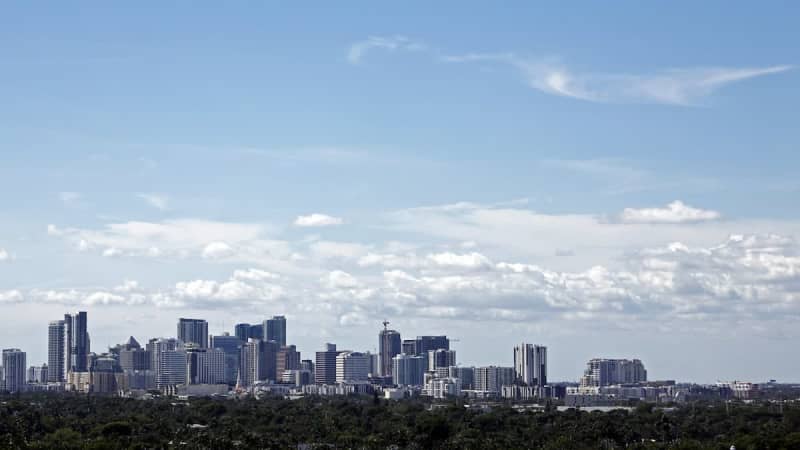Developers relying on Florida’s Live Local Act are lighting up Fort Lauderdale with requests to build.
So far, eight projects are in the pipeline, with more likely on the way under a developer-friendly law designed to get more affordable housing built in a state known for soaring rents.
Three projects have already received approval from City Hall staff, records show. Five more are under review.
Altogether, the projects call for a total of 2,342 apartments and more than 60,000 square feet of commercial space. Nearly half the apartments — 1,156 to be exact — will qualify as affordable workforce housing. The rest — 1,186 apartments — will rent at market rate.
The tallest tower will stand 380 feet high. The shortest: 65 feet.
In keeping with the new state law, the projects are being approved outside the public eye, with no public input from the Fort Lauderdale commission or residents who live nearby.
In an effort to spur the development of affordable housing, the Live Local Act allows builders to ignore height and density caps. Under the law, developers can build to the highest currently allowed height for a commercial or residential building within a one-mile radius.
The projects are required to meet certain zoning and permitting rules, but can be built along commercial corridors throughout Fort Lauderdale, in places they were never meant to rise.
The law allows developers to preempt local zoning laws on height and density if they guarantee that at least 40% of the apartments are affordable to renters making up to 120% of the local area median income for Broward County.
Broward’s median income has risen to $96,200 for 2025. So the maximum income for a household to qualify for Live Local Act programs in Broward has reached $115,440.
Under the law, the affordability requirement must be maintained for at least 30 years.
The three projects below have already received approvals:
Project address: 1055 N. Federal Hwy.
Applicant: 1055 N Federal LLC
Approved: May 13, 2025
376 residential units (207 workforce units and 169 market rate units)
Height: 84 feet, 6 inches (equivalent to 8 stories)
Project address: 2900 W. Broward Blvd.
Applicant: Tatum Martin/Melrose View LLC
Approved: June 13, 2025
162 residential units (all workforce)
Height: 122 feet (equivalent to 12 stories)
Project address: 1101 N. Federal Hwy.
Applicant: GatewayApproved: March 12, 2025
231 residential units (94 workforce units and 137 market rate units)
Height: 150 feet (equivalent to 15 stories)
The five projects below remain under review:
Project address: 1515 and 1535 SE 17 St.
Applicant: Related Group, BH Group and Pebb Enterprises
521 residential units (217 workforce units and 304 market rate)
Height: 380 feet (equivalent to 38 stories)
Project address: 1316 NW Sixth St.
Applicant: LandAmerica Holdings & Investments Group
30 residential units (12 workforce units and 18 market rate units)
Height: 65 feet (equivalent to 6 stories)
Project address: 610 NW Third Ave.
Applicant: 610 LLC
90 residential units (all workforce)
Height: 86 feet, 8 inches (equivalent to 8 stories)
Project address: 1777 S. Andrews Ave.
Applicant: Rechter Holdings Inc., Blacksod Partners and South Andrews Holdings
466 residential units (187 workforce units and 279 market rate units)
Height: 301 feet (equivalent to 30 stories)
Project address: 1801 S. Andrews Ave.
Applicant: 1801 Associates LLC
466 residential units (187 workforce units and 279 market rate units)
Height: 301 feet (equivalent to 30 stories)
Some are worried about the impact the Live Local law will have on neighborhoods.
“I think they did not realize that there would be unintended consequences,” longtime resident Marilyn Mammano said of state legislators.
“Our downtown has no limits on density or height,” said Mammano, president of the Harbordale Civic Association. “So all of a sudden, a lot of properties near downtown are now zoned the same as downtown. It’s pretty much a free-for-all. When you start seeing these buildings go up, it’s going to have a big visual impact and a big density impact.”
Mayor Dean Trantalis says he too is not a fan of the Live Local statute.
He questions whether the law was needed, noting that Fort Lauderdale already gives tax incentives and direct financial contributions to developers willing to build workforce housing.
“There’s always going to be a demand for affordable housing,” Trantalis said. “No matter where you go, these projects always have a waiting list.”
Like other city officials throughout the state, Trantalis says he’s worried about the impact on single-family neighborhoods.
“I think the state Legislature thinks of development as a one size fits all,” he said. “But what happens in Alachua County is not the same as what happens in Broward County. And that’s troubling. Each city has evolved in different ways.”
Commissioner Steve Glassman says he also has reservations.
“I was not a fan when that law was passed,” Glassman said. “I understand the need for more affordable housing. But where I disagree is that it totally bypasses the processes in place that provide for public participation meetings, where a project goes to Planning and Zoning and sometimes the commission. I’m just concerned about the encroachment into the neighborhoods.”
So far, Glassman says the developers who have proposed Live Local projects in his district have had the courtesy and respect to contact him regarding their plans. In turn, Glassman says he has alerted the nearby neighborhoods.
“The developers I’ve been dealing with are not trying to fly under the radar,” Glassman said. “They’re letting people know. And I hope we see that consistently, that the developers do the right thing.”
Robert Lochrie, a land use attorney based in Fort Lauderdale, says he’s been getting calls from more developers interested in building workforce housing since the Live Local Act went into effect two years ago — and for good reason.
“There’s no public meetings and no public hearings,” Lochrie said. “Under the law, it’s an expedited process. But it’s still a very thorough review. Live Local has really set up a new standard for folks who want to do workforce housing. It gives an incredible incentive to developers by allowing for a streamlined process with less layers of review. It cuts through a lot of red tape. It also gives incredible tax breaks.”
Despite all the incentives, building workforce housing remains an expensive venture, Lochrie said.
With the current economic slowdown, will the Live Local law entice more developers to build workforce housing?
“I think the jury is still out on that,” Lochrie said. “The balance of Live Local is to provide robust incentives. But not every development can be a Live Local project.”
Still, a handful of developers are using Live Local to get their project through the review process faster, Lochrie said.
“If a client says they’re going to do 60% affordable housing, my advice will be, ‘Let’s do Live Local.’ It moves things through the process faster. And that’s what it’s for, to expand the speed to market and to facilitate workforce housing near where people work.”
So far, two of Lochrie’s clients have proposed Live Local projects in Fort Lauderdale: The Quay, being developed by Related Group, BH Group and Pebb Enterprises; and The Cove, proposed by developer Jeff Burns.
Burns, founder & CEO of Affiliated Development, said he expects to break ground on the eight-story project in early 2026.
“We’re in the process of finishing the demolition of an abandoned hotel that took us four months to knock down,” Burns said. “We were very eager to get that going. It was an eyesore with a lot of unwanted criminal activity occurring in and around the site.”
The apartment tower will replace The Link, a hotel built in 1981 on the west side of Federal Highway just north of Sunrise Boulevard.
Rent for the affordable housing units at The Cove will start at $1,900 for a one bedroom; $2,800 for a two bedroom; and $3,200 for a three bedroom. Market rate rents will start at $2,500 for a one bedroom; $3,000 for a two bedroom; and $3,800 for a three bedroom.
Thanks to the streamlined review process, Burns said he got staff approval for the project within six months.
“We carved half the time off,” Burns said. “It would have taken a year under the normal process. Live Local speeds things up.”
Saving time helps save money too, Burns said.
“When you’re buying an expensive property, if it takes a year or two before you can break ground, that can eat a hole in your pocket,” Burns said. “That eats into the deal and the returns.”
Not everyone is going to run out and try to build a Live Local project, said Charlie Ladd, a local developer with a long history in Fort Lauderdale.
“There are two kinds of projects: Projects that are approved, and projects that are developed,” he said. “If someone gets a massive project approved, that doesn’t necessarily mean it’s going to be developed. It’s very alluring to get a project approved. But it also has to make economic sense to get built.”
Fans of the Live Local law are hoping developers will build workforce housing despite the economic slowdown. Skeptics — including Ladd — aren’t so sure.
“We’ll see what gets built,” he said. “Can you justify it on a 30-story high-rise where you’re committed to lower rents for 30 years? That’s the question. And I don’t know that there’s a firm answer out there. Live Local is just another tool. People are still figuring out how it works. Density is expensive. And with Live Local, you’re having to keep down your value. You have to make sure it makes economic sense.”









